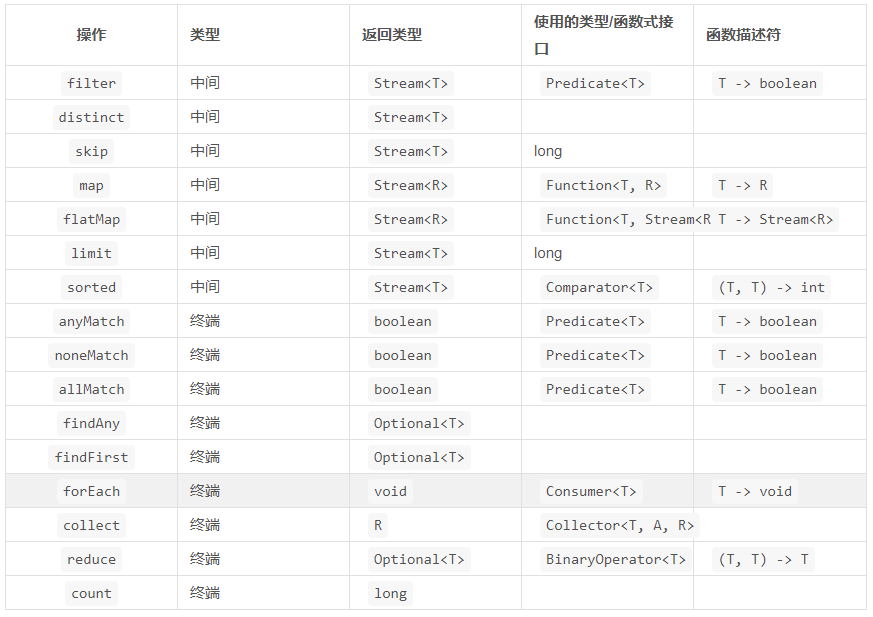# :-: Stream API (上)
# Stream API 上
## 使用流
### 創建流
在使用流之前,首先需要擁有一個數據源,并通過StreamAPI提供的一些方法獲取該數據源的流對象。數據源可以有多種形式:
**1\. 集合**
這種數據源較為常用,通過stream()方法即可獲取流對象:
~~~
List<Person> list = new ArrayList<Person>();
Stream<Person> stream = list.stream();
~~~
**2\. 數組**
通過Arrays類提供的靜態函數stream()獲取數組的流對象:
~~~
String[] names = {"chaimm","peter","john"};
Stream<String> stream = Arrays.stream(names);
~~~
**3\. 值**
直接將幾個值變成流對象:
~~~
Stream<String> stream = Stream.of("chaimm","peter","john");
~~~
**4\. 文件**
~~~
try(Stream lines = Files.lines(Paths.get(“文件路徑名”),Charset.defaultCharset())){
//可對lines做一些操作
}catch(IOException e){
}
~~~
**5\. iterator**
**創建無限流**
~~~
Stream.iterate(0, n -> n + 2)
.limit(10)
.forEach(System.out::println);
~~~
> PS:Java7簡化了IO操作,把打開IO操作放在try后的括號中即可省略關閉IO的代碼。
### 篩選 filter
filter 函數接收一個Lambda表達式作為參數,該表達式返回boolean,在執行過程中,流將元素逐一輸送給filter,并篩選出執行結果為true的元素。
如,篩選出所有學生:
~~~
List<Person> result = list.stream()
.filter(Person::isStudent)
.collect(toList());
~~~
### 去重distinct
去掉重復的結果:
~~~
List<Person> result = list.stream()
.distinct()
.collect(toList());
~~~
### 截取
截取流的前N個元素:
~~~
List<Person> result = list.stream()
.limit(3)
.collect(toList());
~~~
### 跳過
跳過流的前n個元素:
~~~
List<Person> result = list.stream()
.skip(3)
.collect(toList());
~~~
### 映射
對流中的每個元素執行一個函數,使得元素轉換成另一種類型輸出。流會將每一個元素輸送給map函數,并執行map中的Lambda表達式,最后將執行結果存入一個新的流中。
如,獲取每個人的姓名(實則是將Perosn類型轉換成String類型):
~~~
List<Person> result = list.stream()
.map(Person::getName)
.collect(toList());
~~~
### 合并多個流
例:列出List中各不相同的單詞,List集合如下:
~~~
List<String> list = new ArrayList<String>();
list.add("I am a boy");
list.add("I love the girl");
list.add("But the girl loves another girl");
~~~
思路如下:
首先將list變成流:
~~~
list.stream();
~~~
按空格分詞:
~~~
list.stream()
.map(line->line.split(" "));
~~~
分完詞之后,每個元素變成了一個String\[\]數組。
將每個`String[]`變成流:
~~~
list.stream()
.map(line->line.split(" "))
.map(Arrays::stream)
~~~
此時一個大流里面包含了一個個小流,我們需要將這些小流合并成一個流。
將小流合并成一個大流:用`flatMap`替換剛才的 map
~~~
list.stream()
.map(line->line.split(" "))
.flatMap(Arrays::stream)
~~~
去重
~~~
list.stream()
.map(line->line.split(" "))
.flatMap(Arrays::stream)
.distinct()
.collect(toList());
~~~
### 是否匹配任一元素:anyMatch
anyMatch用于判斷流中是否存在至少一個元素滿足指定的條件,這個判斷條件通過Lambda表達式傳遞給anyMatch,執行結果為boolean類型。
如,判斷list中是否有學生:
~~~
boolean result = list.stream()
.anyMatch(Person::isStudent);
~~~
### 是否匹配所有元素:allMatch
allMatch用于判斷流中的所有元素是否都滿足指定條件,這個判斷條件通過Lambda表達式傳遞給anyMatch,執行結果為boolean類型。
如,判斷是否所有人都是學生:
~~~
boolean result = list.stream()
.allMatch(Person::isStudent);
~~~
### 是否未匹配所有元素:noneMatch
noneMatch與allMatch恰恰相反,它用于判斷流中的所有元素是否都不滿足指定條件:
~~~
boolean result = list.stream()
.noneMatch(Person::isStudent);
~~~
### 獲取任一元素findAny
findAny能夠從流中隨便選一個元素出來,它返回一個Optional類型的元素。
~~~
Optional<Person> person = list.stream().findAny();
~~~
### 獲取第一個元素findFirst
~~~
Optional<Person> person = list.stream().findFirst();
~~~
### 歸約
歸約是將集合中的所有元素經過指定運算,折疊成一個元素輸出,如:求最值、平均數等,這些操作都是將一個集合的元素折疊成一個元素輸出。
在流中,reduce函數能實現歸約。
reduce函數接收兩個參數:
1. 初始值
2. 進行歸約操作的Lambda表達式
**元素求和:自定義Lambda表達式實現求和**
例:計算所有人的年齡總和
~~~
int age = list.stream().reduce(0, (person1,person2)->person1.getAge()+person2.getAge());
~~~
1. reduce的第一個參數表示初試值為0;
2. reduce的第二個參數為需要進行的歸約操作,它接收一個擁有兩個參數的Lambda表達式,reduce會把流中的元素兩兩輸給Lambda表達式,最后將計算出累加之和。
**元素求和:使用Integer.sum函數求和**
上面的方法中我們自己定義了Lambda表達式實現求和運算,如果當前流的元素為數值類型,那么可以使用Integer提供了sum函數代替自定義的Lambda表達式,如:
~~~
int age = list.stream().reduce(0, Integer::sum);
~~~
Integer類還提供了`min`、`max`等一系列數值操作,當流中元素為數值類型時可以直接使用。
### 數值流的使用
采用reduce進行數值操作會涉及到基本數值類型和引用數值類型之間的裝箱、拆箱操作,因此效率較低。
當流操作為純數值操作時,使用數值流能獲得較高的效率。
**將普通流轉換成數值流**
StreamAPI提供了三種數值流:IntStream、DoubleStream、LongStream,也提供了將普通流轉換成數值流的三種方法:mapToInt、mapToDouble、mapToLong。
如,將Person中的age轉換成數值流:
~~~
IntStream stream = list.stream().mapToInt(Person::getAge);
~~~
**數值計算**
每種數值流都提供了數值計算函數,如max、min、sum等。如,找出最大的年齡:
~~~
OptionalInt maxAge = list.stream()
.mapToInt(Person::getAge)
.max();
~~~
由于數值流可能為空,并且給空的數值流計算最大值是沒有意義的,因此max函數返回OptionalInt,它是Optional的一個子類,能夠判斷流是否為空,并對流為空的情況作相應的處理。
此外,mapToInt、mapToDouble、mapToLong進行數值操作后的返回結果分別為:OptionalInt、OptionalDouble、OptionalLong
## 中間操作和收集操作

- 序
- 快速開始
- 環境要求
- 環境準備
- 工程導入
- 工程運行
- 技術基礎
- Java8
- Lambda
- Lambda 受檢異常處理
- Stream 簡介
- Stream API 一覽
- Stream API(上)
- Stream API(下)
- Optional 干掉空指針
- 函數式接口
- 新的日期 API
- Lombok
- SpringMVC
- Swagger
- Mybaties
- Mybaties-plus
- 開發初探
- 新建微服務工程
- 第一個API
- API鑒權
- API響應結果
- Redis 緩存
- 第一個CRUD
- 建表
- 建Entity
- 建Service和Mapper
- 新增API
- 修改API
- 刪除API
- 查詢API
- 單條查詢
- 多條查詢
- 分頁
- 微服務遠程調用
- 聲明式服務調用Feign
- 熔斷機制 Hystrix
- 開發進階
